I settled down to write this blog on Remembrance Sunday, the day we commemorate the contribution of British and Commonwealth military and civilian servicemen and women in the two World Wars and later conflicts.
I thought it would be appropriate to write again about some of the most moving of the memorials to be found around the City and suggest that this may be nice time to visit them since, for a few weeks now, wreaths, crosses and other tokens of remembrance will still be in place.
On Monday I visited the London Troops Memorial outside the Royal Exchange …
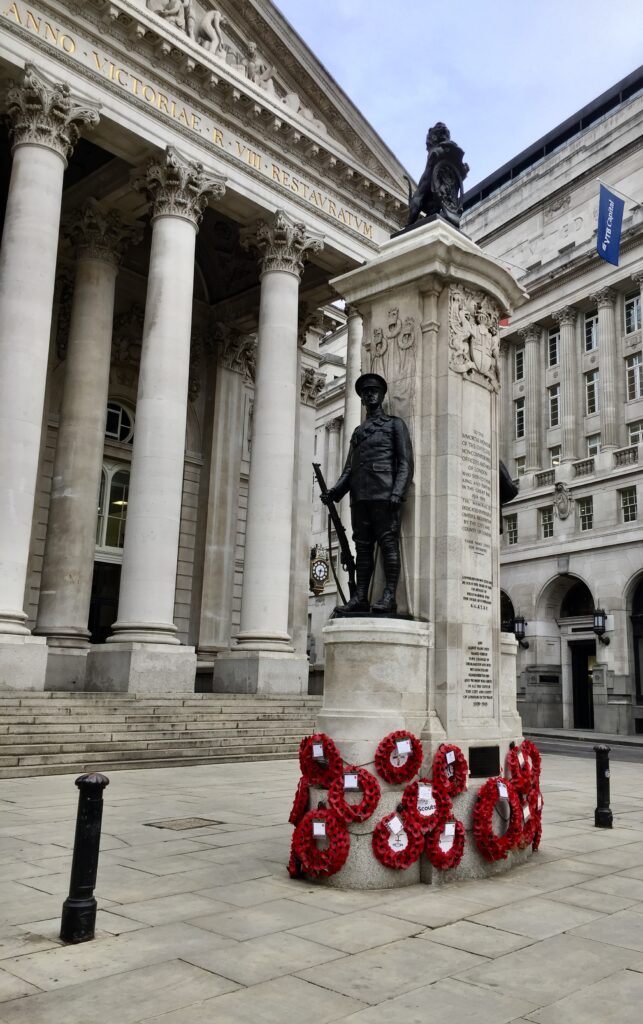
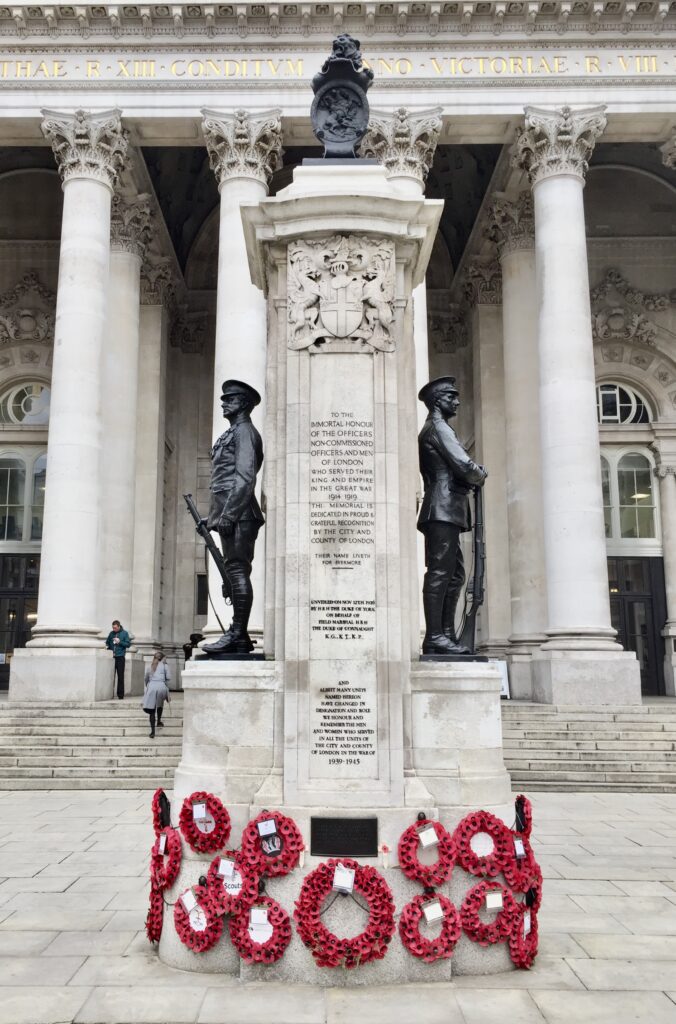
Your attention may be drawn to two battalions with unusual names, the Cyclists and the Artists’ Rifles …
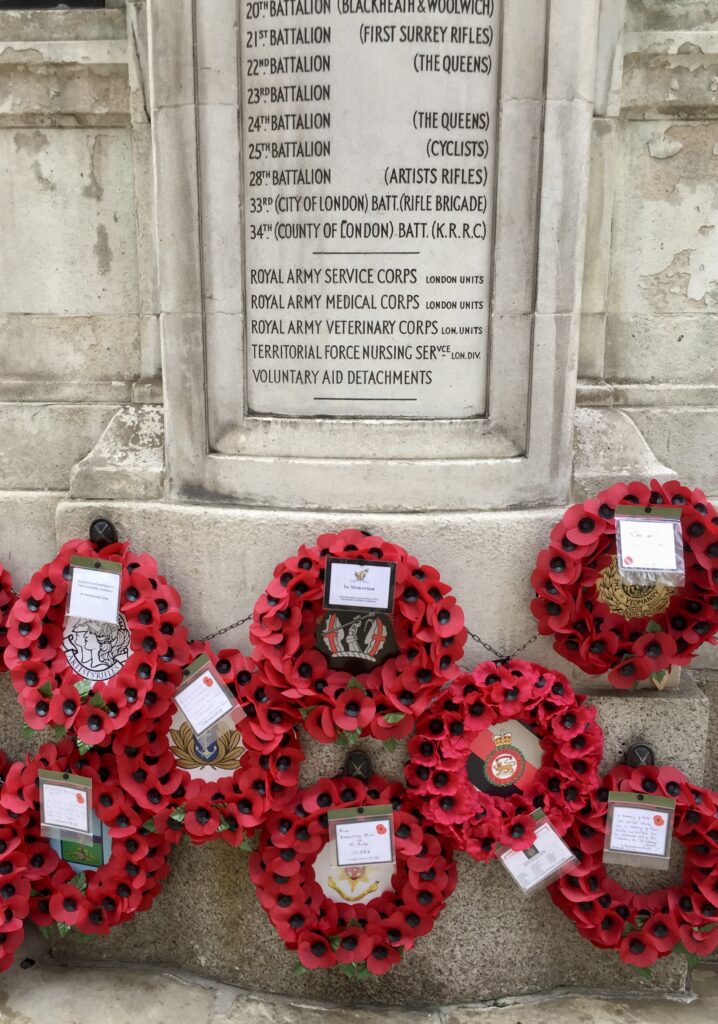
Bicycles were commonly used in the First World War, not only for troop transport, but also for carrying dispatches. Field telephones were limited by the need for cables, and ‘wireless’ communications were still unreliable, so cyclists – and runners, motorbike riders, and pigeons and dogs – were frequently preferred, by the Allies and the German army.
I came across two interesting recruitment posters for the Cyclists at the Imperial War Museum. The first paints a quite romantic picture of the battalion going into combat in the bucolic setting of what looks like an English village. Nothing like the industrial level mass slaughter that these poor men would have to face in the First World War…
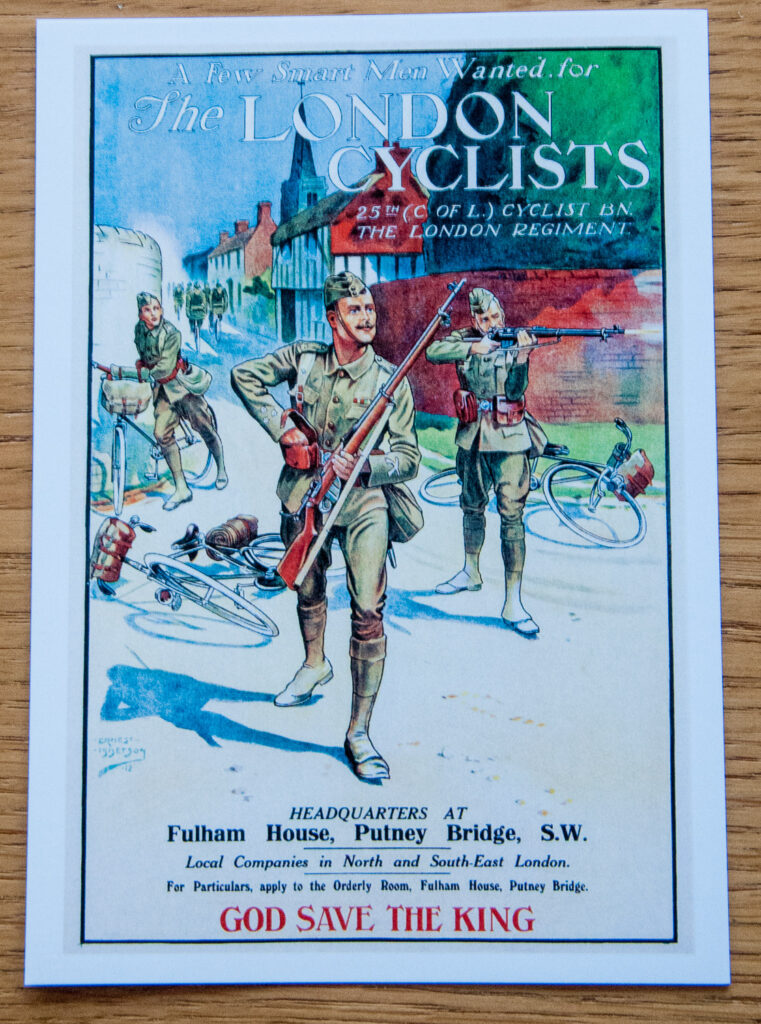
This one made me smile taking into account, as it does, the poor state of early 20th century dental hygiene …
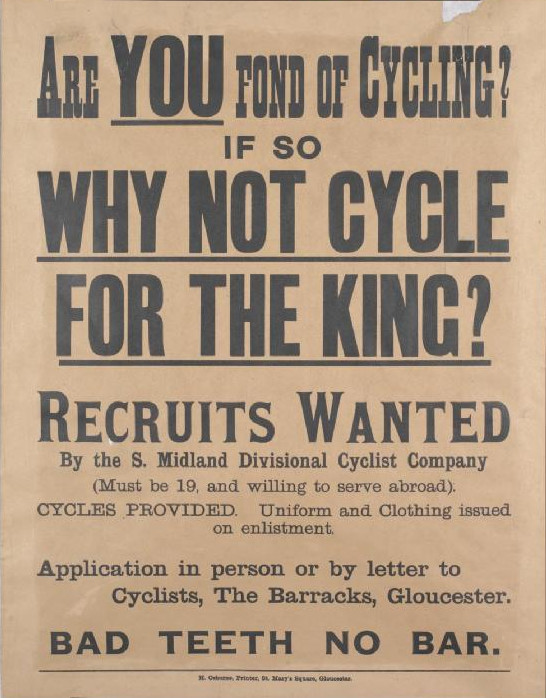
The last British soldier to die in the First World War, Private Ellison, was a cyclist. Here Theresa May bows her head at his grave on the 2018 centenary …
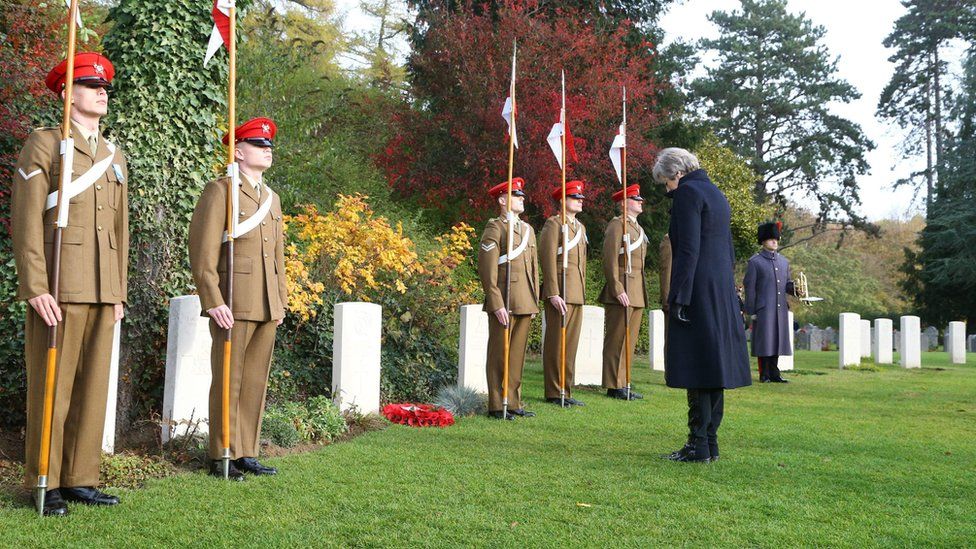
The story of the Artists’ Rifles is a fascinating one.
The regiment was formed in 1859 by art student Edward Starling. It was a volunteer regiment and formed out of the widespread fear of a French invasion. Many of those who joined were artists, actors, musicians and architects and its first headquarters was located at Burlington House. The First World War would see the regiment literally leading from the front as they become a training regiment for officers in this period. It is also for this reason that the Artists Rifles had one of the highest casualty rates of any regiment.
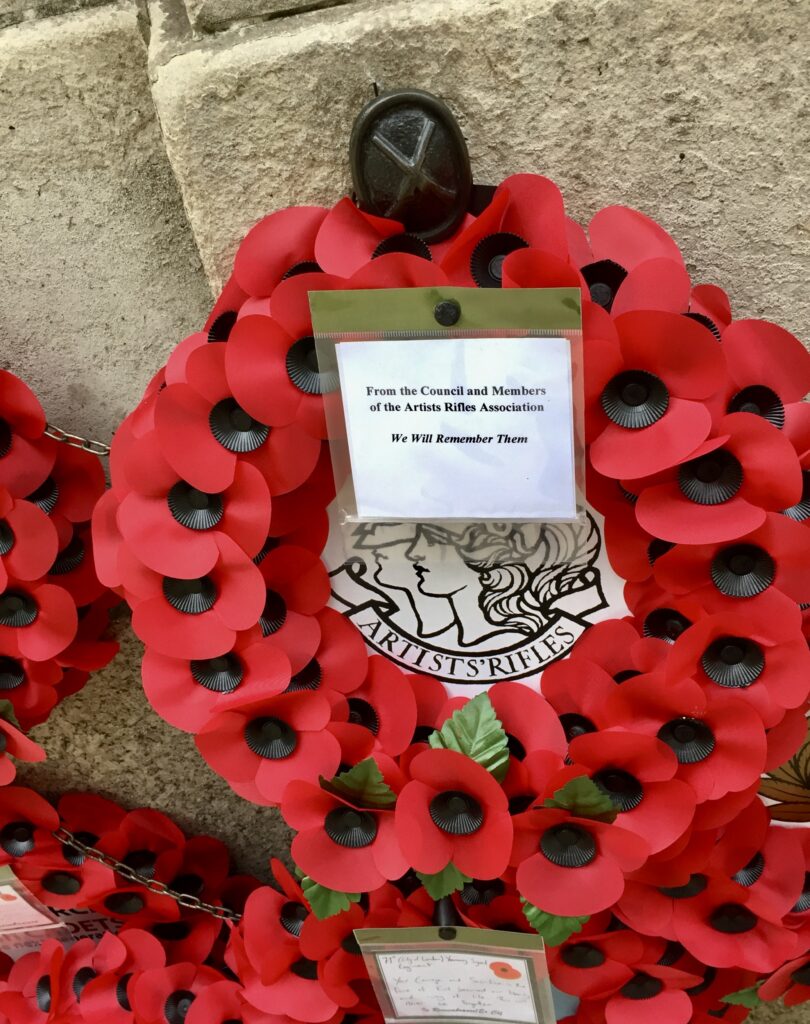
This painting, Over the Top by John Nash, depicts his regiment in action. On 30th December 1917, the 1st Artists Rifles counter-attacked at Welsh Ridge, south-west of Cambrai. Nash called the action ‘pure murder’ as most of the company were killed. A sergeant, he counted himself lucky to escape the carnage …
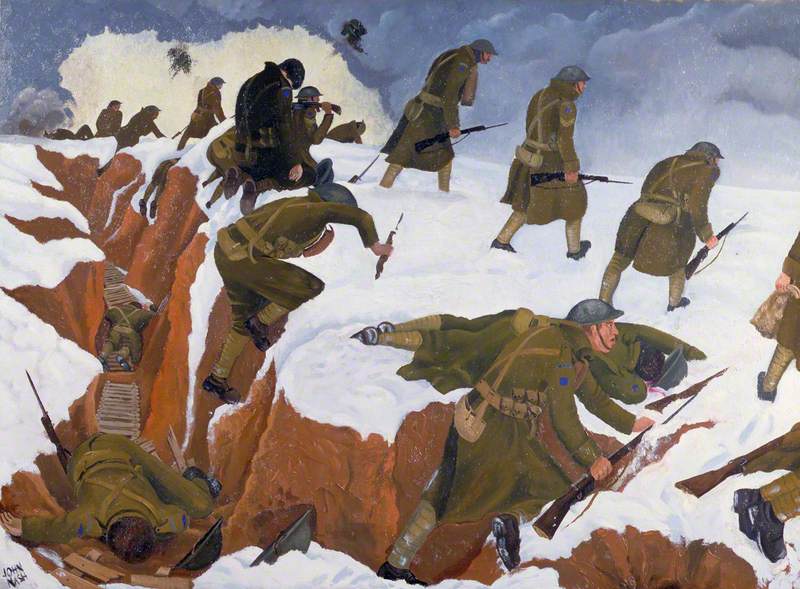
During the Great War, 2,003 of the regiment’s men were killed and over 3,000 wounded. Members of the regiment would be awarded eight Victoria Crosses and over 850 other military awards including the Distinguished Service Order (awarded 52 times) and the Military Cross (awarded 822 times). They were also mentioned in dispatches 564 times.
Incidentally, in the very first episode of the fourth series of Blackadder he becomes an artist, believing that this is his chance to escape the trenches. However, it is revealed that the artist’s role is to undertake a highly dangerous job – to draw the enemy’s defences from No Man’s Land.
The last episode of the series is renowned for its moving climax and you can view it here : Good luck everyone.
I also recommend a visit to the Tower Hill Memorial which commemorates men and women of the Merchant Navy and Fishing Fleets who died in both World Wars and who have no known grave.
The First World War section commemorates almost 12,000 Mercantile Marine casualties and was designed by Sir Edwin Lutyens with sculpture by Sir William Reid-Dick. It was unveiled by Queen Mary on 12 December 1928 …
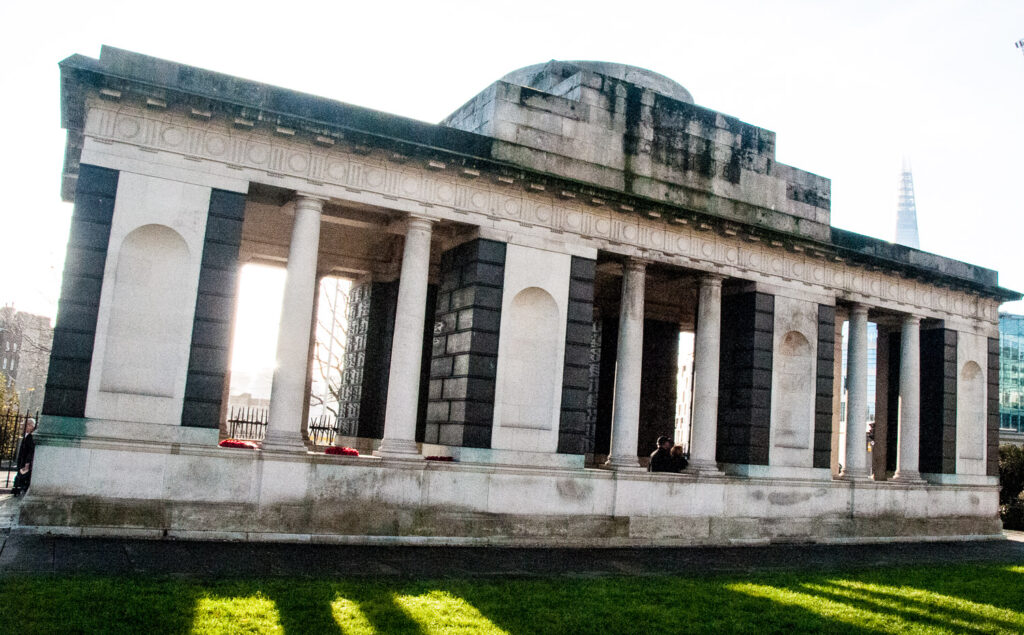
The Second World War extension, which commemorates almost 24,000 casualties, was designed by Sir Edward Maufe, with sculpture by Charles Wheeler. It was unveiled by Queen Elizabeth II on 5 November 1955.
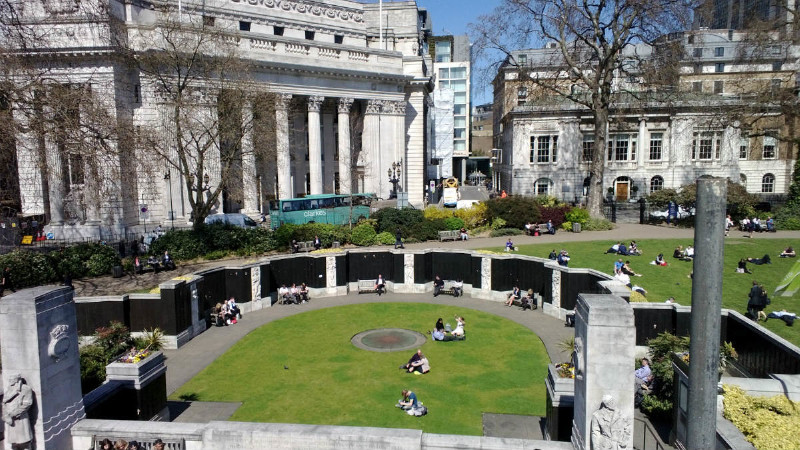
In the background, Neptune (standing on the old Port of London Authority headquarters) points towards the sea …
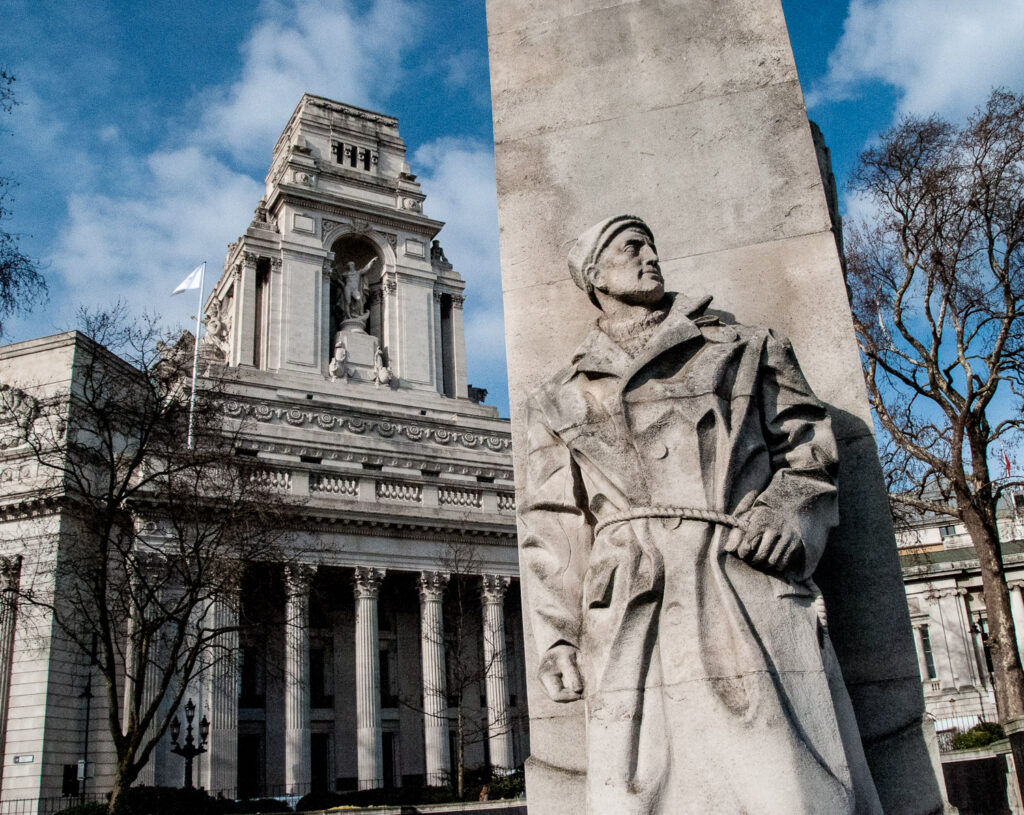
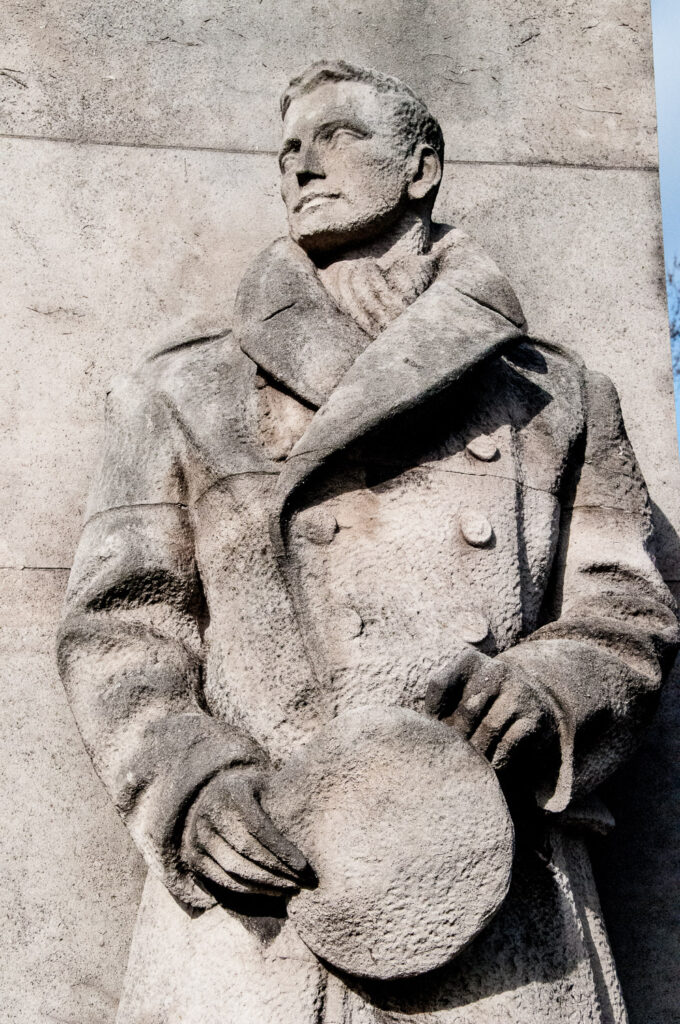
Within the garden the walls are overlaid with bronze plaques on which the names of the men and their ships are inscribed in relief. At regular intervals, between the inscription panels, are allegorical figures representing the Seven Seas. Here is one of them, Neptune with his trident …
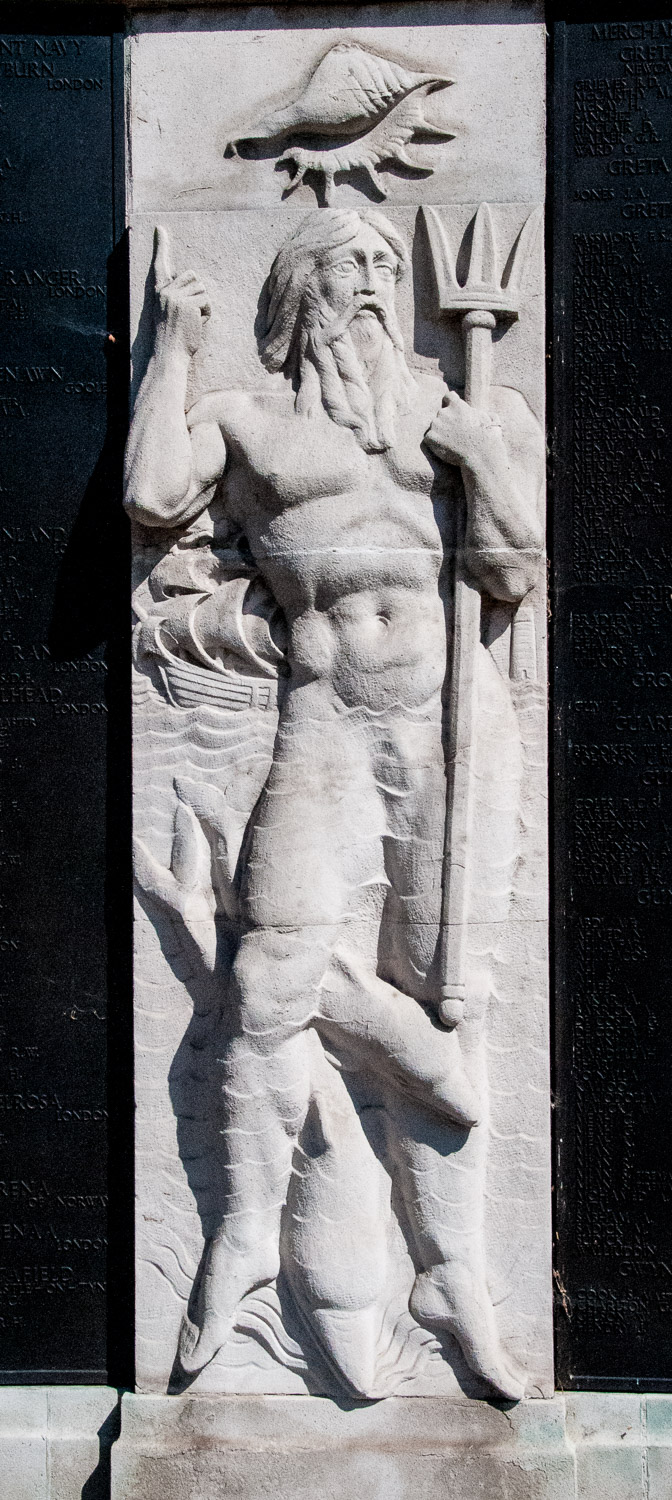
And another, a mermaid combing her hair …
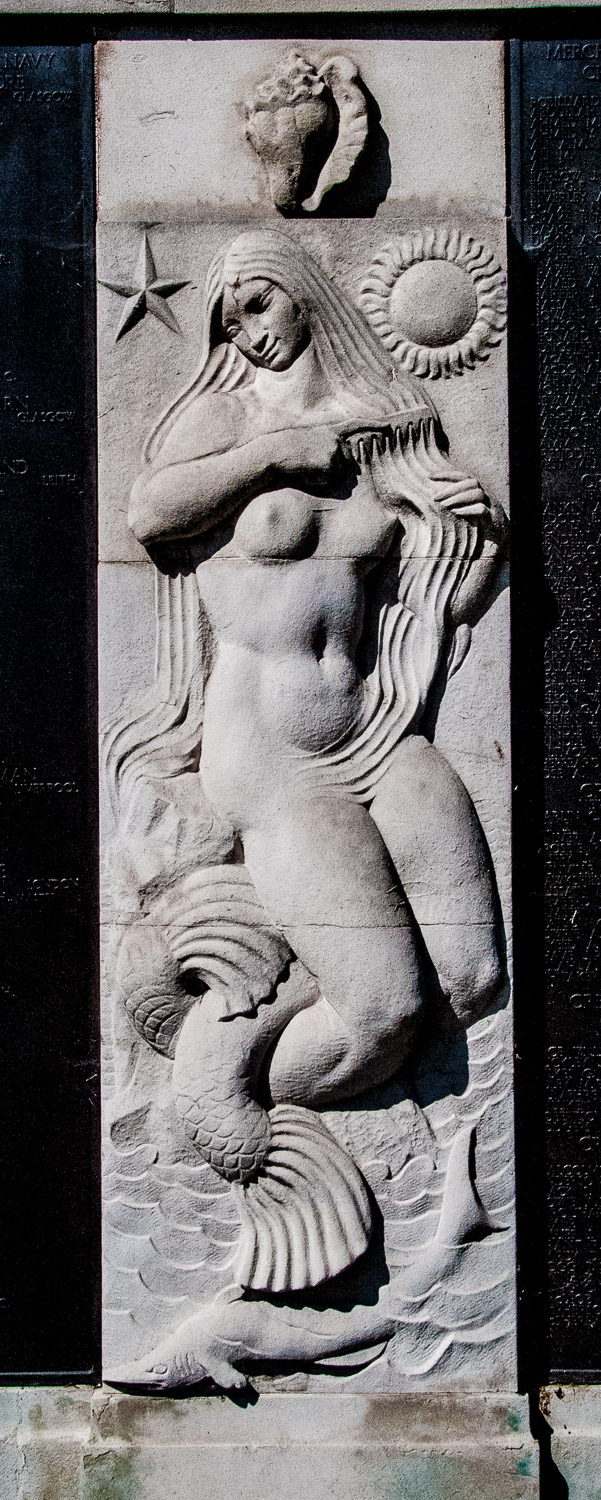
Images from my visit last November …
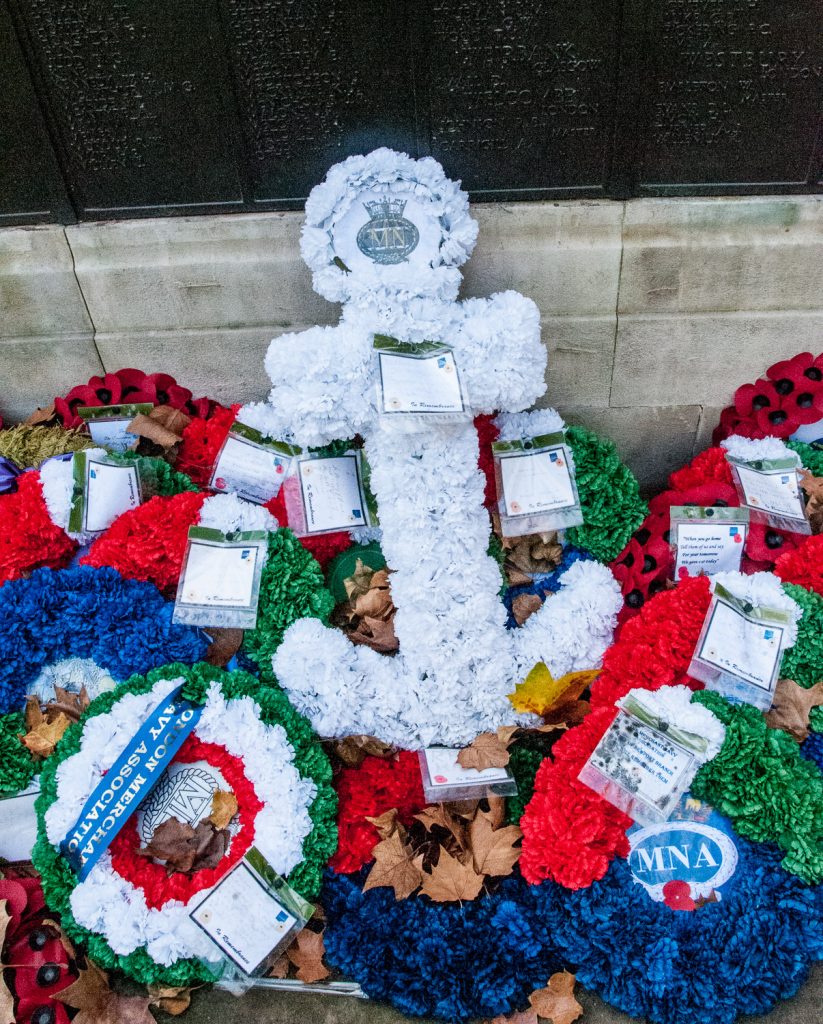
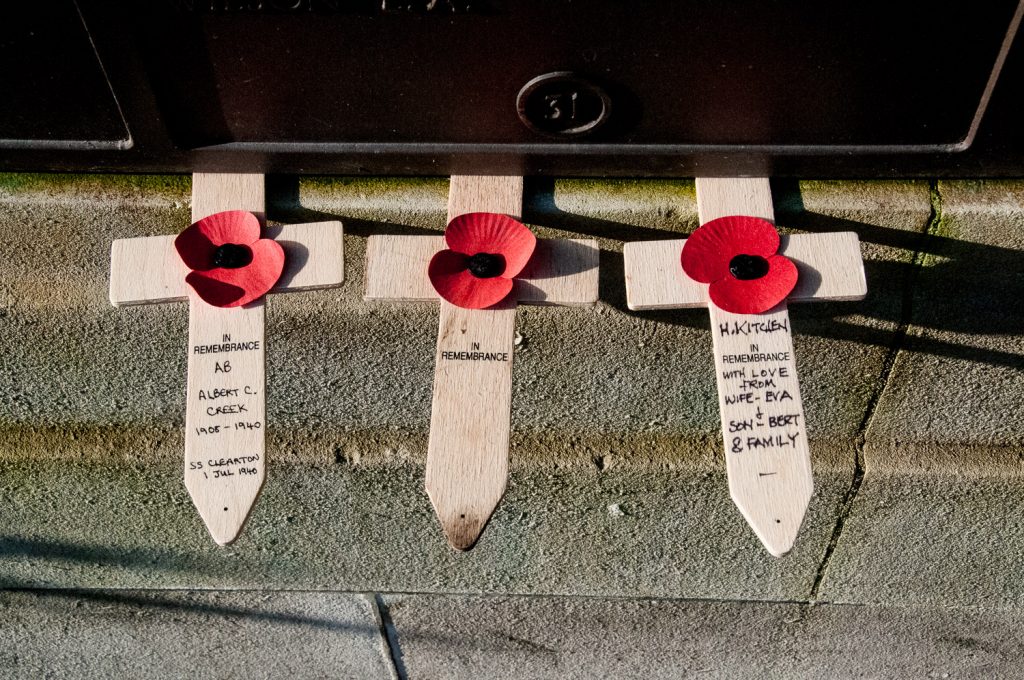
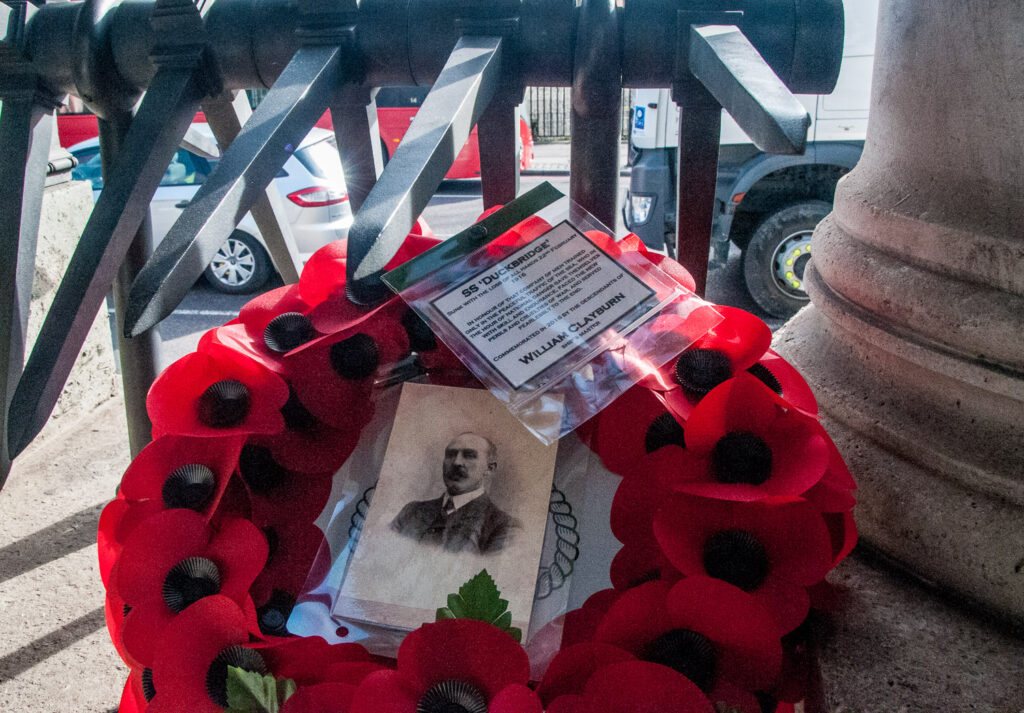
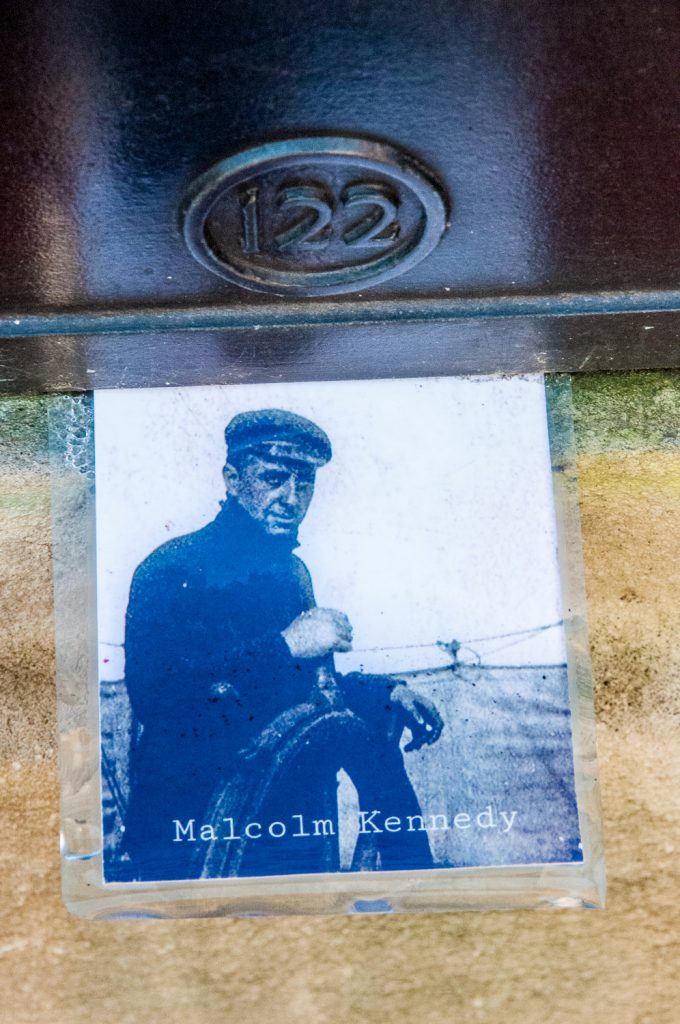
I noticed a small cross resting on one of the allegorical figures, just above the dolphin’s head …
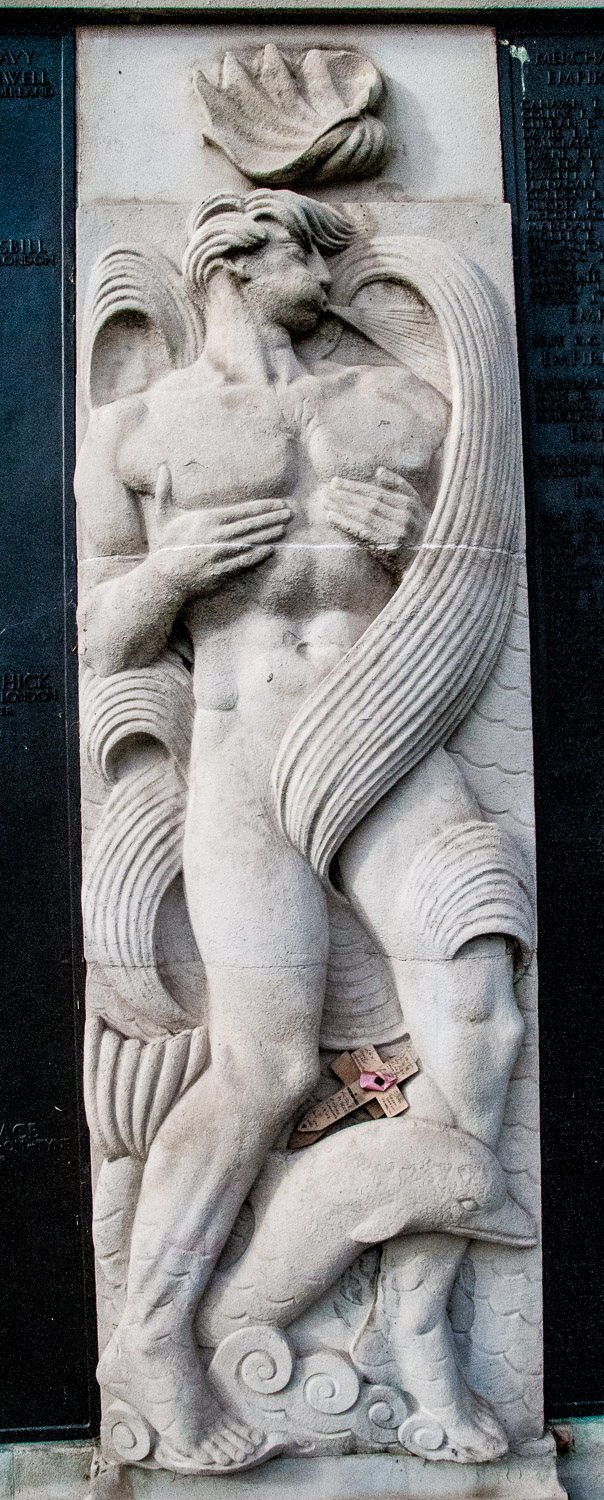
Here it is in close up …
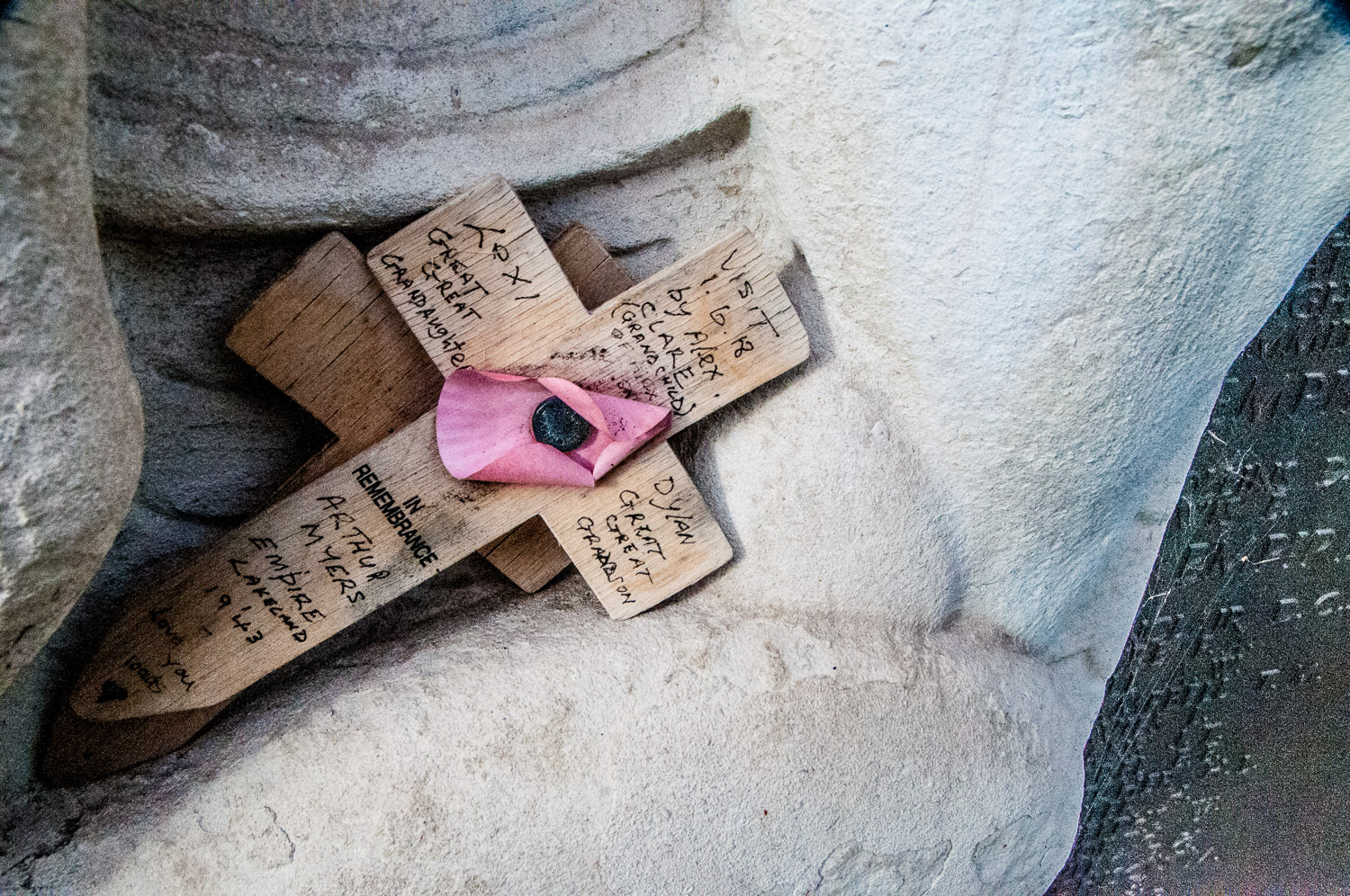
How wonderful. Arthur Myers remembered by a grandchild and two great, great grandchildren. His ship, the Empire Lakeland, was sunk by a U Boat on 11 March 1943.
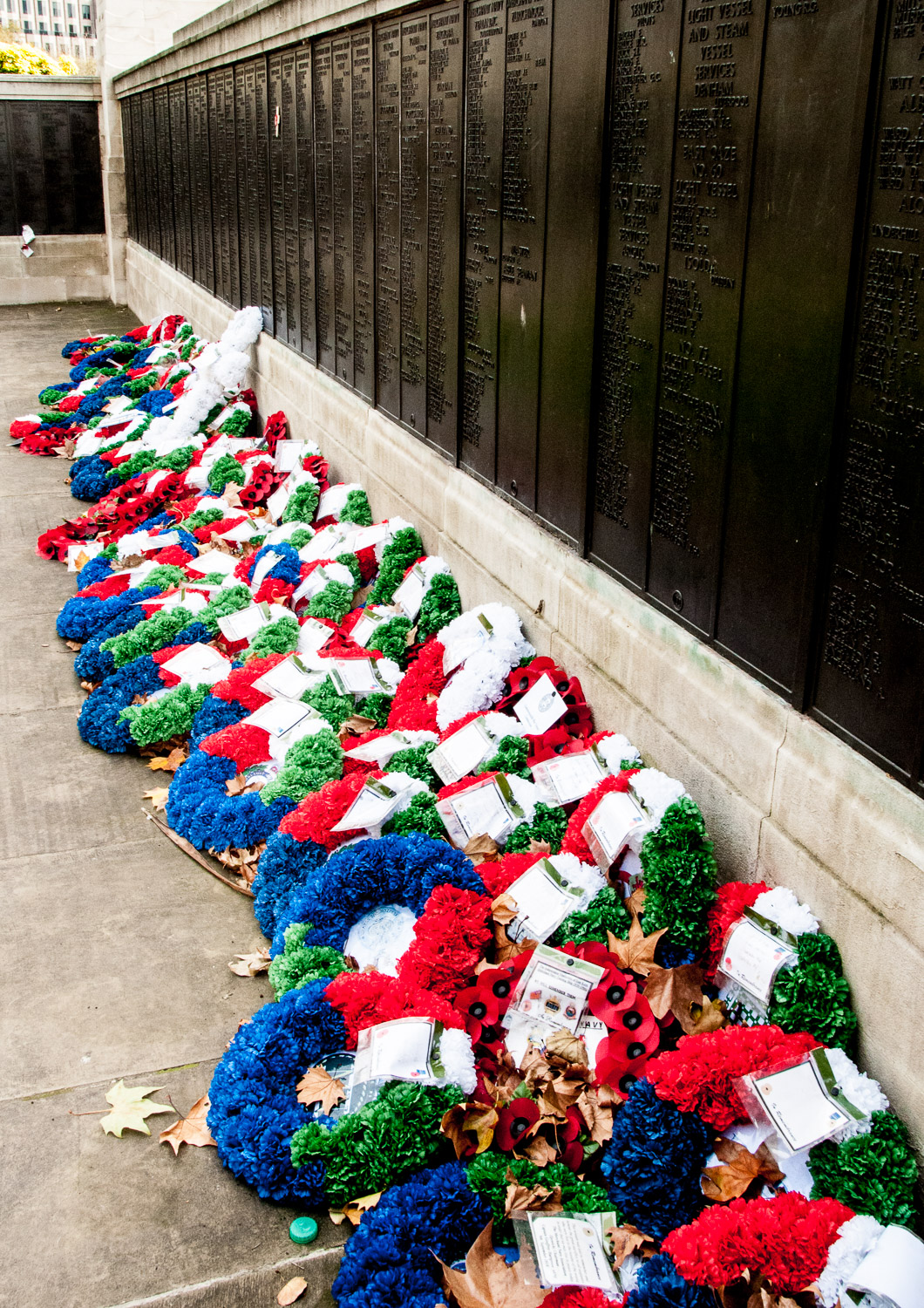
On 2 April 1982, Argentine forces landed in and captured the Falklands Islands. A task force was dispatched in order to retake the territory and this was accomplished when the occupying forces surrendered on 14 June that year. Nine members of the Merchant Navy and eight members of the Royal Fleet Auxiliary were killed in the conflict and their names are recorded here beneath those of their ships …
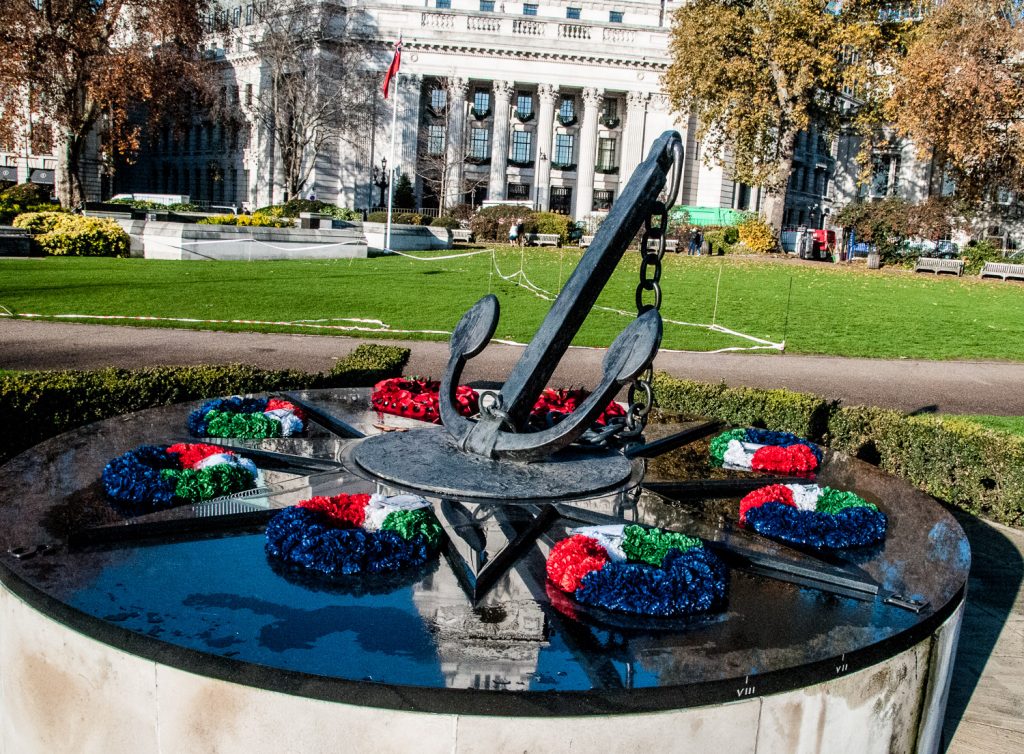
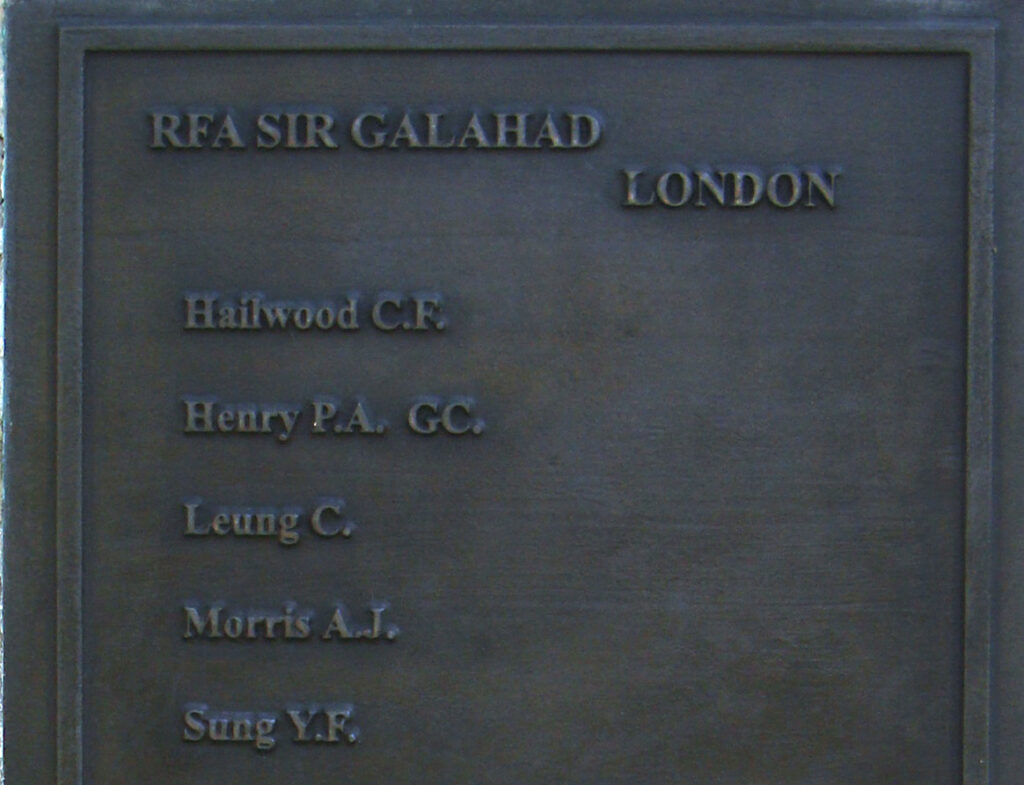
There is a Korean War Memorial outside St Sepulchre-without-Newgate Church (EC1A 9DQ) …
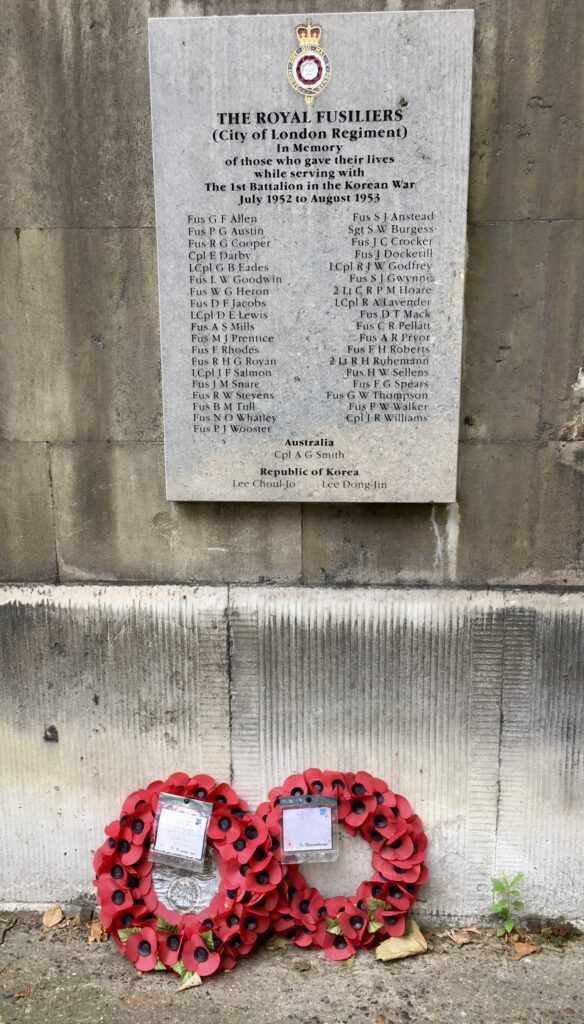
The Southwark Cathedral World War I bronze remembrance plaque is beautiful …
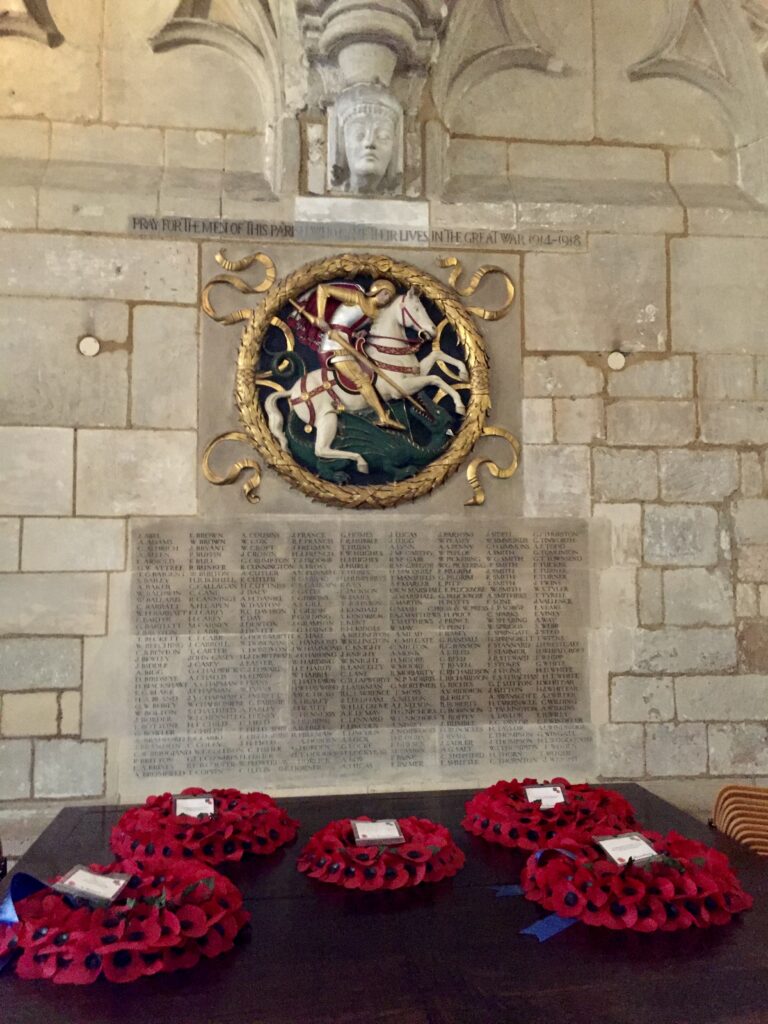
Another suggestion for a visit is the National Submarine War Memorial on Victoria Embankment (EC4Y 0HJ). Although able to hide when submerged, once struck the vessels were often unable to rise to the surface and became effectively underwater coffins. In the First World War fifty four boats were lost and with them the lives of 138 officers and 1,225 men. At the inauguration in 1922 Rear Admiral Sinclair, the Chief of the Submarine Service, reminded those present that, during the Great War …
The number of those killed in the Submarine Service was greater in proportion to its size than any other branch of His Majesty’s fighting forces … one third of the total personnel.
In November 1959 new panels commemorating Second World war losses were unveiled by Rear Admiral B W Taylor.
Wright and Moore, writing for the 20th Century Architecture website, describe the memorial as a complex mixture of narrative and symbolism …
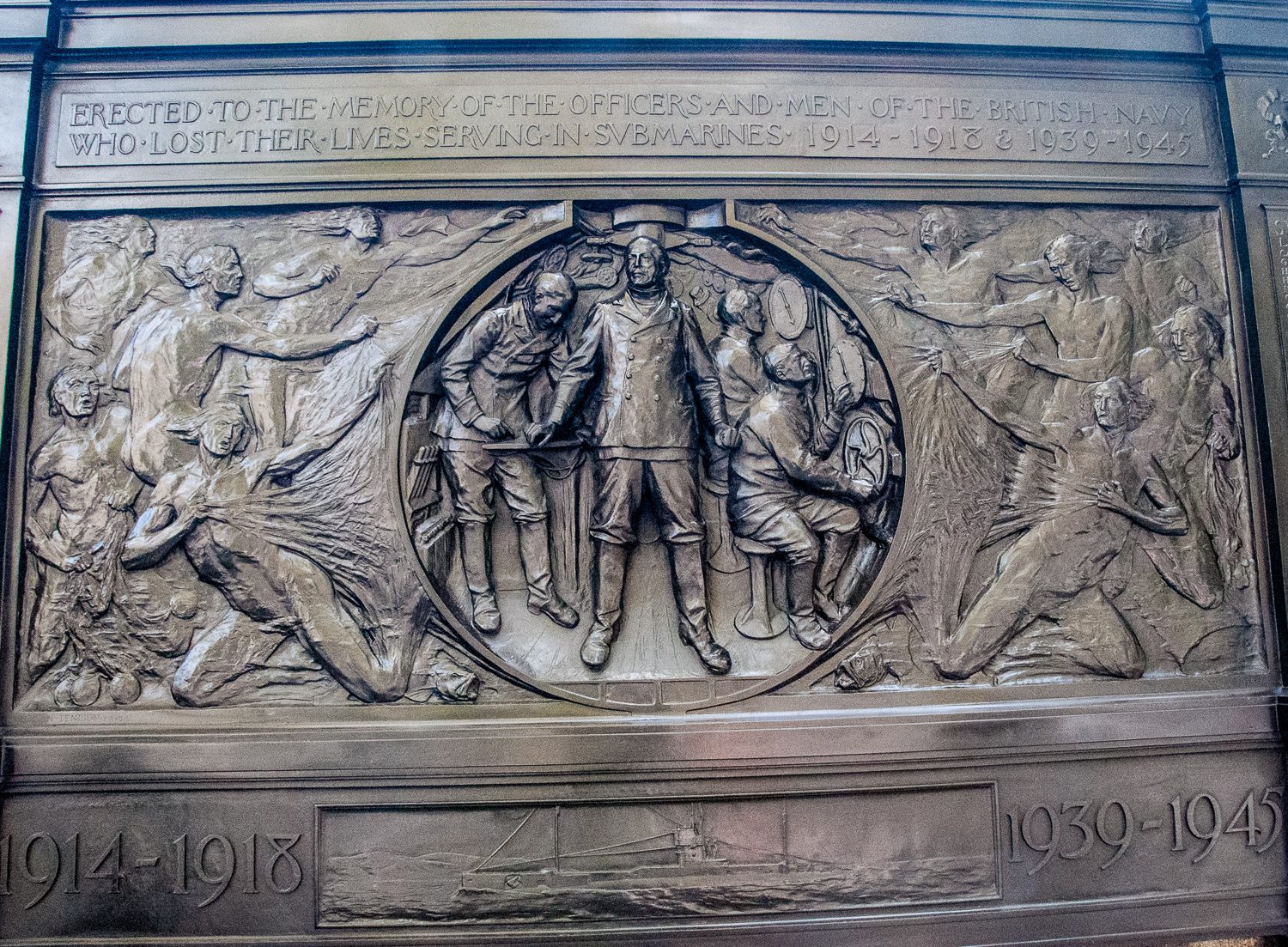
Sculptor: F B Hitch Architect: A H R Tenison Founder: E J Parlanti
The central figures recreate the scene set inside the submarine exaggerating it into a small, claustrophobic tunnel. The crew use charts and follow dials, the captain is braced at the centre with the periscope behind his head. Around the vessel a shallow relief depicts an array of sea creatures or mermen appearing to trap and haul the submarine in fishing nets, reminding us that the submarines were as much prey to the tempestuous elements as they were to the enemy.
On both corners are allegorical figures. Next to the list of vessels lost between 1914 and 1918, Truth holds up her mirror. Just further to the left in the picture are two of the 40 bronze wreath hooks in the form of anchors …
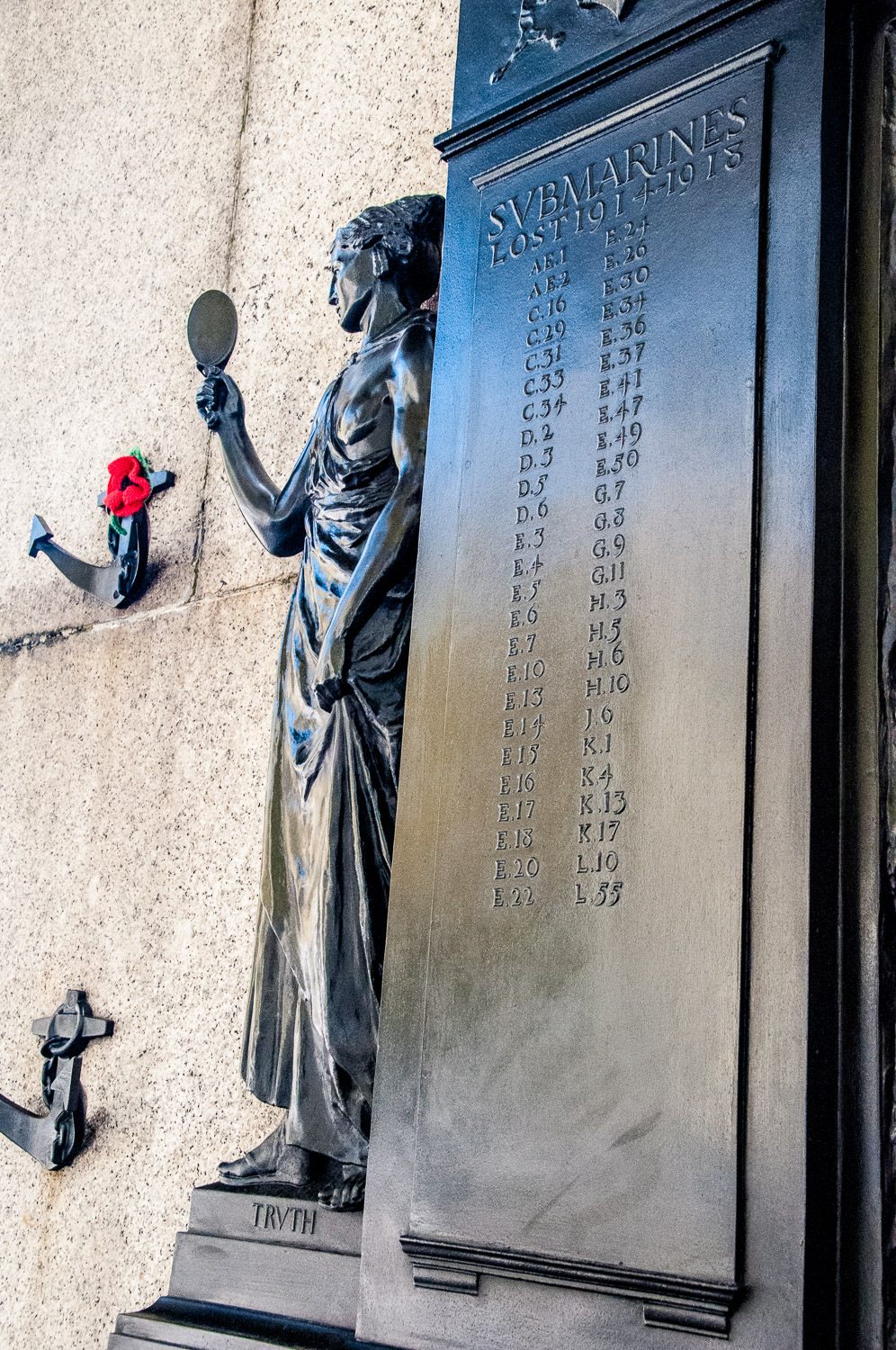
On the right, next to the vessels lost in the Second World War, Justice wears a blindfold and as usual holds a sword and scales …
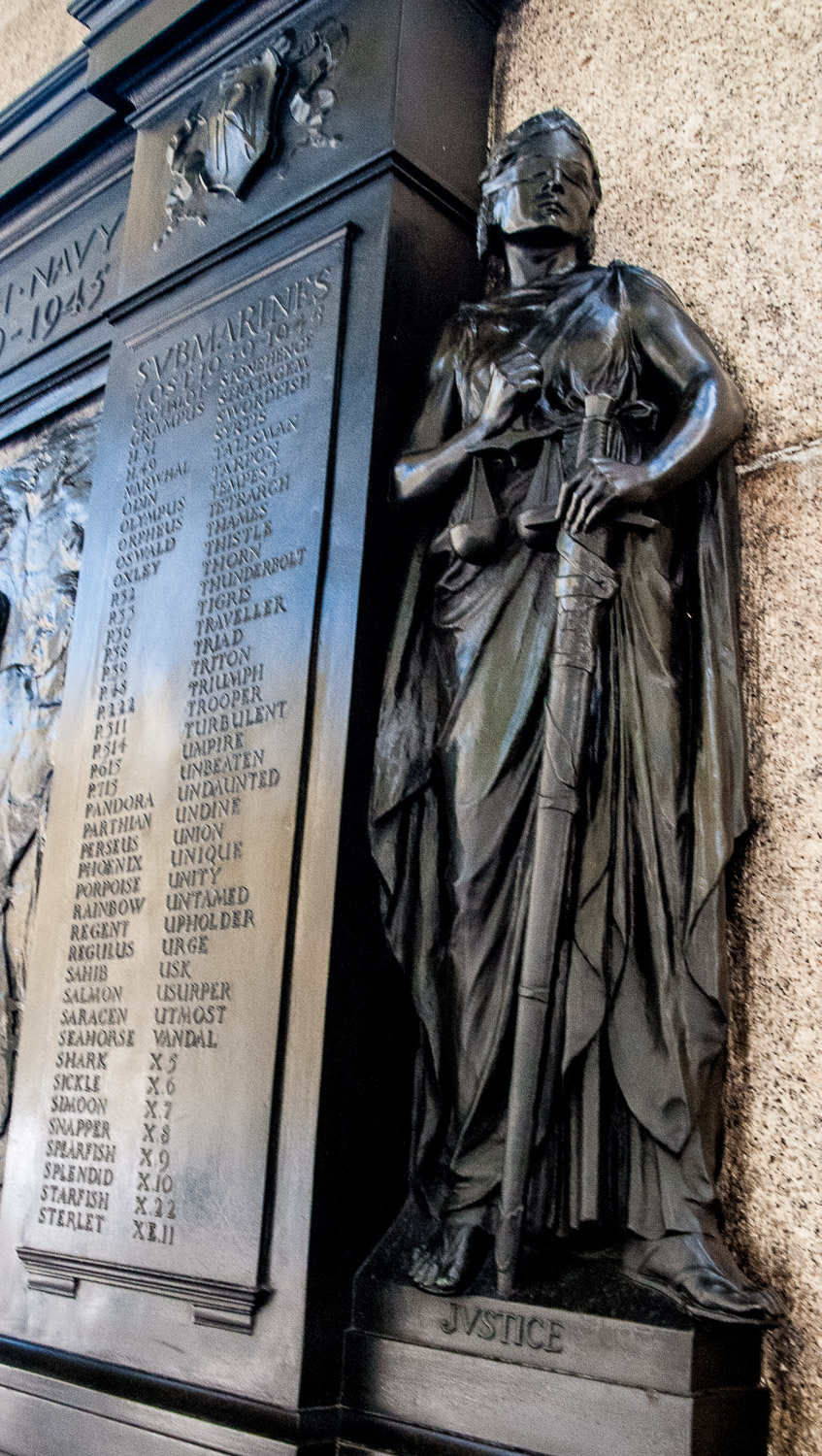
Here is an image from this year’s service …
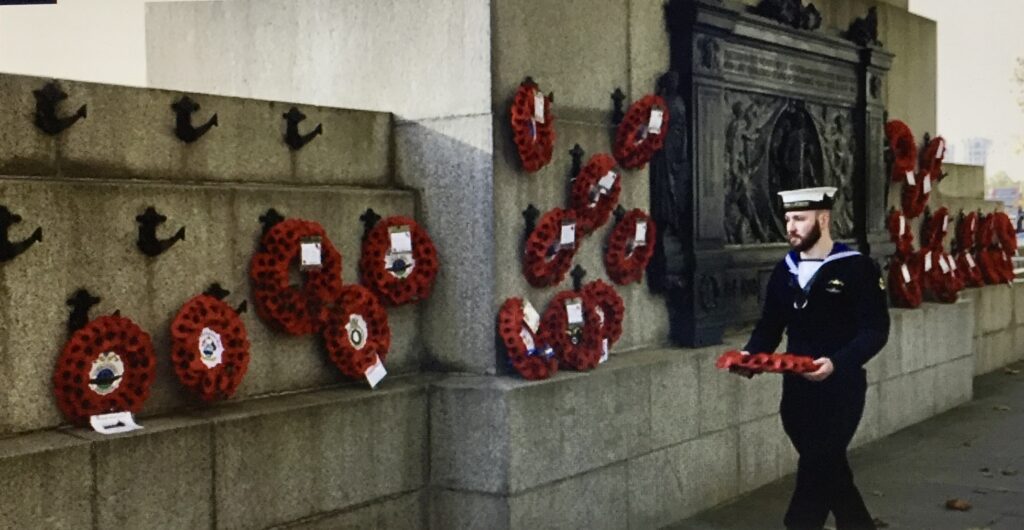
And finally, the Memorial at the entrance to the church of St Bartholomew the Great …
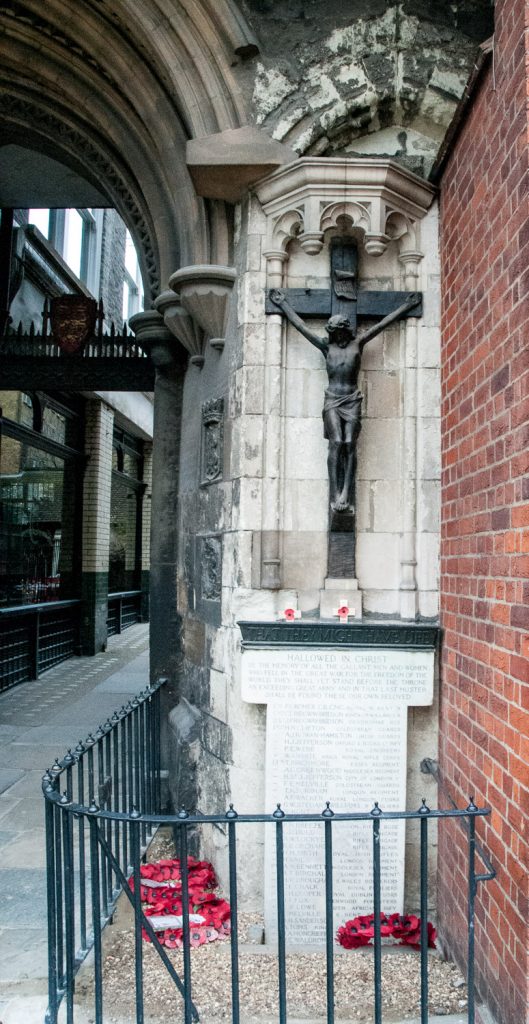
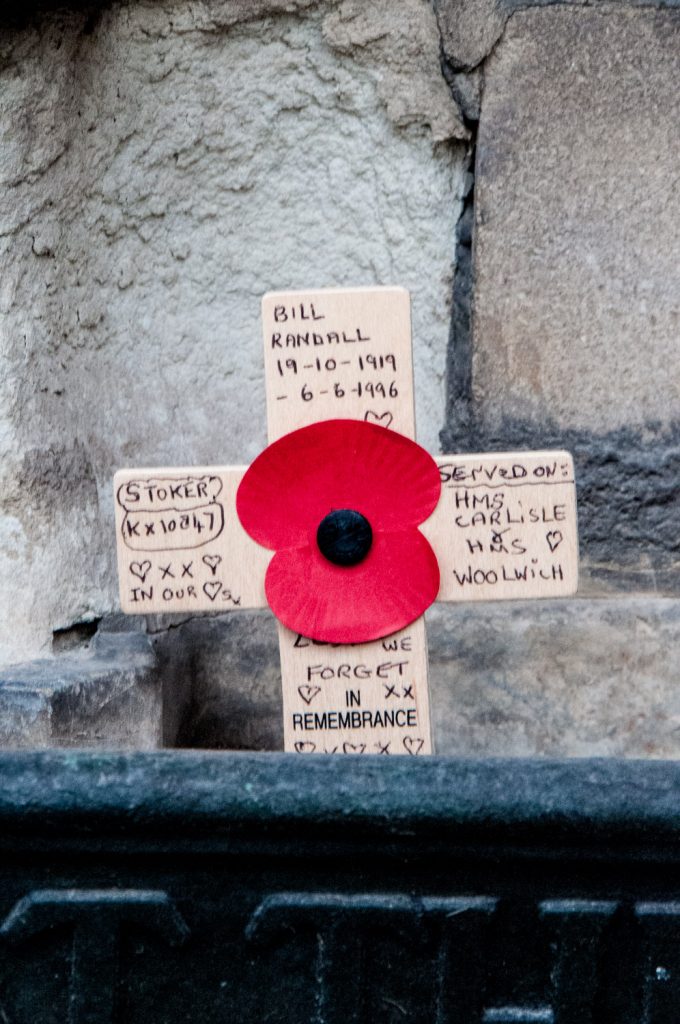
Much of the late 19th and early 20th century church restoration work was carried out by Sir Aston Webb (1849-1930) and he also designed the memorial. It includes the name of his son Philip, who was killed in action on 25th September 1916 …
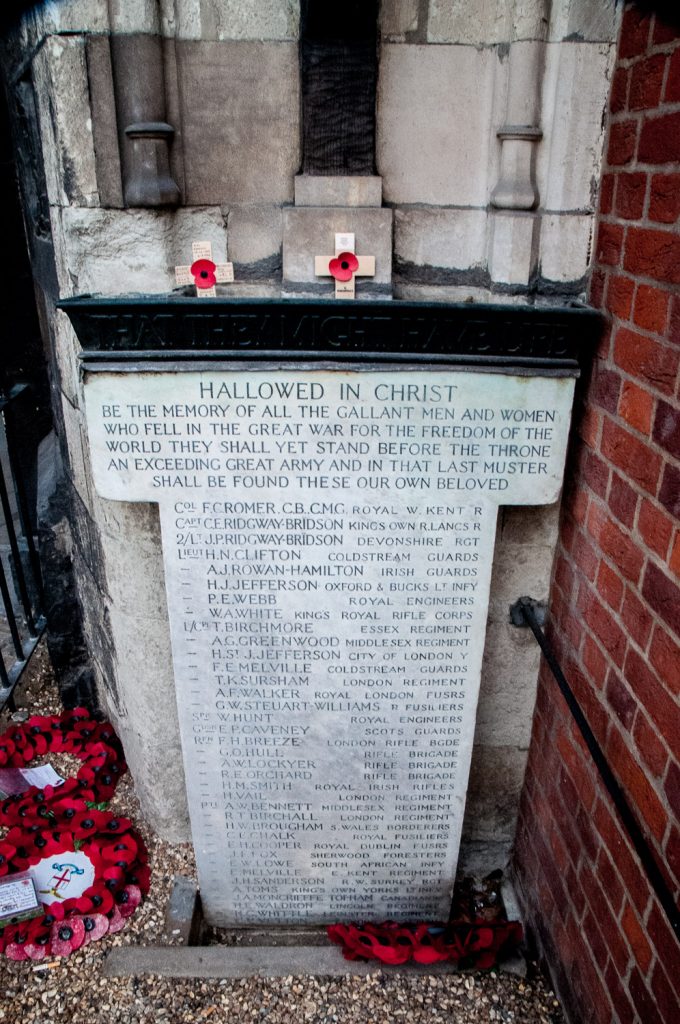
If you would like to follow me on Instagram here is the link …
